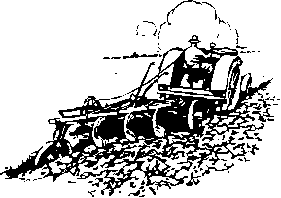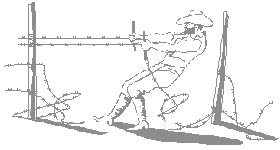Amputation - Student Reference Sheet
Agricultural industry ranks as the most hazardous type of work in the United States. The use of machinery, exposure to the elements, and the general nature of the work make the risk of injury greater for those who work in production agriculture. Equipment such as combines, tractors, bush hogs, augers, power takeoffs (PTOs), and conveyor belts have potential to cause severe damage to limbs and the upper body. Amputations are 2 ½ times more likely to occur in farming than in any other industry, and as much as 11% of all agricultural injuries are amputations.
Limb
loss can be classified into four causes: entanglement, entrapment,
crushing, and infection. Entanglement involves getting caught
in a moving  part of machinery. Loose clothing or attachments like gloves,
baggy shirts, dangling strings and long hair can catch easily
on rotating power takeoff stubs and shafts, in belts and pulleys,
and in moving parts of balers and combines. The use of tighter
clothing that will tear easily and keeping hair pulled back
and up will help prevent entanglement. Removing dangling drawstrings
on jackets and shoe laces will prevent being pulled in. Remember,
"If it dangles, it tangles". To prevent entanglement,
the easiest rule to remember is shut down the machinery.
It is also important that others cannot accidentally start
the equipment while it is being worked on. The second rule
is to disable the equipment.
part of machinery. Loose clothing or attachments like gloves,
baggy shirts, dangling strings and long hair can catch easily
on rotating power takeoff stubs and shafts, in belts and pulleys,
and in moving parts of balers and combines. The use of tighter
clothing that will tear easily and keeping hair pulled back
and up will help prevent entanglement. Removing dangling drawstrings
on jackets and shoe laces will prevent being pulled in. Remember,
"If it dangles, it tangles". To prevent entanglement,
the easiest rule to remember is shut down the machinery.
It is also important that others cannot accidentally start
the equipment while it is being worked on. The second rule
is to disable the equipment.
Entrapment occurs when something is trapped and pulled into a device, such as augers, combine heads, and hay balers. It is important to keep distance between your body and these devices. Augers should always have guards in place and be turned off when worked on.
Crushing
injuries occur when some part of the body is trapped between
a force and a surface. These  incidents
usually involve post drivers and heavy machinery, as well
as falling objects. Crushing injures the inside of the arm
or leg, causing internal damage that may lead to amputation.
incidents
usually involve post drivers and heavy machinery, as well
as falling objects. Crushing injures the inside of the arm
or leg, causing internal damage that may lead to amputation.
Limb loss can be prevented by turning off machinery before
working on it, disabling equipment so it cannot be started
by others, avoiding rotating PTO shafts, maintaining shields
and guards, and wearing tight-fitting clothing that does not
tangle.
Limb loss may occur instantly, or the limb may survive initial
injury but not be saved even after intensive therapy. Infection
due to the dirty wounds often means the limb must be removed,
sometimes weeks or even months after the injury.
The results of limb loss include more than losing an arm or leg. Your entire life and the lives of those around you are changed forever. The physical changes mean you will always look different than before, but the damage goes beyond that. You have to learn new ways of doing things and develop new ways of accomplishing your activities, even simple things you never thought twice about before. You have to learn to use other body parts as substitutes for the lost limb. If an artificial limb is available and you are able to purchase one, you must learn to use it just as a new baby learns to use their limbs. The limb loss will affect your balance, reaction time, and your overall health (shoulder problems, increased problems with arthritis, and "other parts wear out faster").
The psychological effects of limb loss are difficult to overcome as well. You have to prove to yourself and to others that you can do a task. Your body will still believe it has that part, and you can continue to feel pain and itching for years even though the limb is no longer there. You will have to think more before you act on anything, always figuring out how to do things other people do without a second thought.
 Someone
else will have to do your share of the farm work for a while
as well. It takes about six months for the wound to really
heal, and it has to be toughened up and strengthened before
you can even wear an artificial limb. Your family, friends,
and probably hired labor will have to fill your shoes. If
the injury occurs during planting or harvesting times (most
common times) your crop will suffer, because the attention
and time will be centered on you, not the crop and work needing
to be done. When you return to farm work, you will be slower,
and it will take extra time to get jobs done until you get
accustomed and find new ways to do things. Time is money.
Someone
else will have to do your share of the farm work for a while
as well. It takes about six months for the wound to really
heal, and it has to be toughened up and strengthened before
you can even wear an artificial limb. Your family, friends,
and probably hired labor will have to fill your shoes. If
the injury occurs during planting or harvesting times (most
common times) your crop will suffer, because the attention
and time will be centered on you, not the crop and work needing
to be done. When you return to farm work, you will be slower,
and it will take extra time to get jobs done until you get
accustomed and find new ways to do things. Time is money.
What about the cost of an amputation? Even if everything goes well, you still have to spend money on upkeep of the prosthesis to keep it in working order. Many insurance companies will pay for only one prosthetic limb, so you may have to pay out of your pocket for the next one (maybe out of your savings for that new truck).
This curriculum guide was supported by Grant Number 1 R01/CCR414307 from NIOSH. Its contents are solely the responsibility of the authors and do not necessarily represent the official views of NIOSH. Special thanks to Dr. Ted Scharf.
Disclaimer and Reproduction Information: Information in NASD does not represent NIOSH policy. Information included in NASD appears by permission of the author and/or copyright holder. More